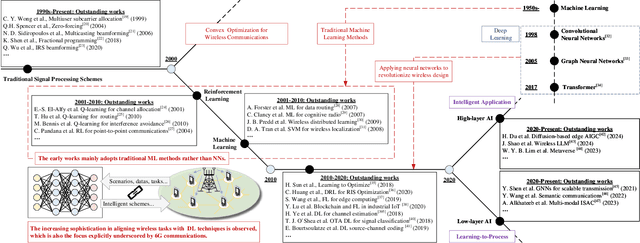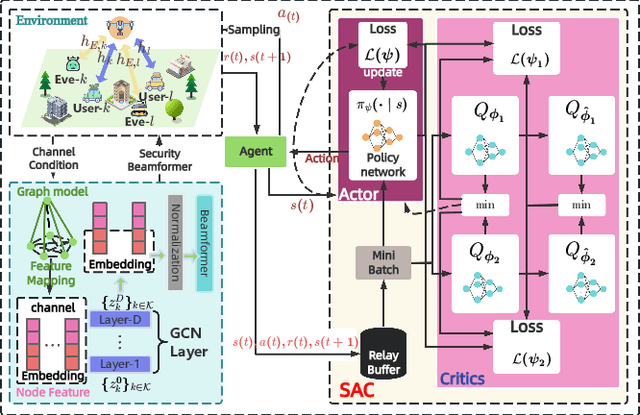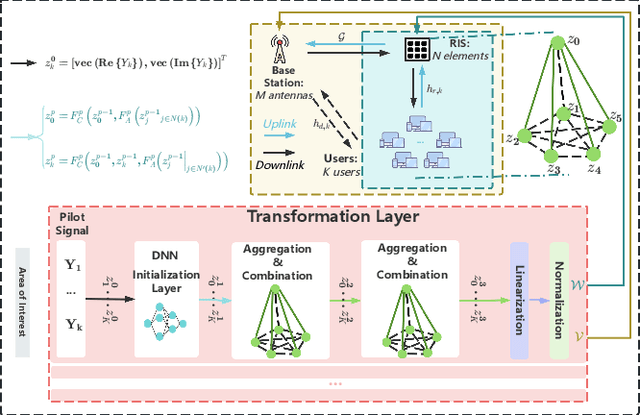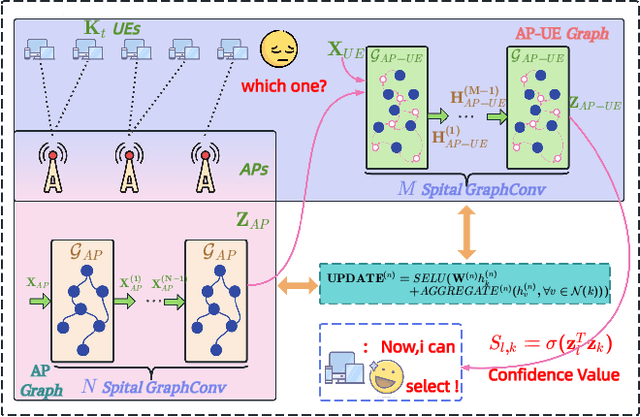Bo Ai
Sherman
Embodied AI-Enhanced IoMT Edge Computing: UAV Trajectory Optimization and Task Offloading with Mobility Prediction
Dec 24, 2025Abstract:Due to their inherent flexibility and autonomous operation, unmanned aerial vehicles (UAVs) have been widely used in Internet of Medical Things (IoMT) to provide real-time biomedical edge computing service for wireless body area network (WBAN) users. In this paper, considering the time-varying task criticality characteristics of diverse WBAN users and the dual mobility between WBAN users and UAV, we investigate the dynamic task offloading and UAV flight trajectory optimization problem to minimize the weighted average task completion time of all the WBAN users, under the constraint of UAV energy consumption. To tackle the problem, an embodied AI-enhanced IoMT edge computing framework is established. Specifically, we propose a novel hierarchical multi-scale Transformer-based user trajectory prediction model based on the users' historical trajectory traces captured by the embodied AI agent (i.e., UAV). Afterwards, a prediction-enhanced deep reinforcement learning (DRL) algorithm that integrates predicted users' mobility information is designed for intelligently optimizing UAV flight trajectory and task offloading decisions. Real-word movement traces and simulation results demonstrate the superiority of the proposed methods in comparison with the existing benchmarks.
A Geometry Map-Based Site-Specific Propagation Channel Model for Urban Scenarios
Nov 19, 2025Abstract:With the rapid deployments of 5G and 6G networks, accurate modeling of urban radio propagation has become critical for system design and network planning. However, conventional statistical or empirical models fail to fully capture the influence of detailed geometric features on site-specific channel variances in dense urban environments. In this paper, we propose a geometry map-based propagation channel model that directly extracts key parameters from a 3D geometry map and incorporates the Uniform Theory of Diffraction (UTD) to recursively compute multiple diffraction fields, thereby enabling accurate prediction of site-specific large-scale path loss and time-varying Doppler characteristics in urban scenarios. A well-designed identification algorithm is developed to efficiently detect buildings that significantly affect signal propagation. The proposed model is validated using urban measurement data, showing excellent agreement of path loss in both line-of-sight (LOS) and nonline-of-sight (NLOS) conditions. In particular, for NLOS scenarios with complex diffractions, it outperforms the 3GPP and simplified models, reducing the RMSE by 7.1 dB and 3.18 dB, respectively. Doppler analysis further demonstrates its accuracy in capturing time-varying propagation characteristics, confirming the scalability and generalization of the model in urban environments.
GNN-Enabled Robust Hybrid Beamforming with Score-Based CSI Generation and Denoising
Nov 10, 2025Abstract:Accurate Channel State Information (CSI) is critical for Hybrid Beamforming (HBF) tasks. However, obtaining high-resolution CSI remains challenging in practical wireless communication systems. To address this issue, we propose to utilize Graph Neural Networks (GNNs) and score-based generative models to enable robust HBF under imperfect CSI conditions. Firstly, we develop the Hybrid Message Graph Attention Network (HMGAT) which updates both node and edge features through node-level and edge-level message passing. Secondly, we design a Bidirectional Encoder Representations from Transformers (BERT)-based Noise Conditional Score Network (NCSN) to learn the distribution of high-resolution CSI, facilitating CSI generation and data augmentation to further improve HMGAT's performance. Finally, we present a Denoising Score Network (DSN) framework and its instantiation, termed DeBERT, which can denoise imperfect CSI under arbitrary channel error levels, thereby facilitating robust HBF. Experiments on DeepMIMO urban datasets demonstrate the proposed models' superior generalization, scalability, and robustness across various HBF tasks with perfect and imperfect CSI.
Fast Time-Varying mmWave MIMO Channel Estimation and Reconstruction: An Efficient Rank-Aware Matrix Completion Method
Nov 08, 2025Abstract:We address the problem of fast time-varying channel estimation in millimeter-wave (mmWave) MIMO systems with imperfect channel state information (CSI) and facilitate efficient channel reconstruction. Specifically, leveraging the low-rank and sparse characteristics of the mmWave channel matrix, a two-phase rank-aware compressed sensing framework is proposed for efficient channel estimation and reconstruction. In the first phase, a robust rank-one matrix completion (R1MC) algorithm is used to reconstruct part of the observed channel matrix through low-rank matrix completion (LRMC). To address abrupt rank changes caused by user mobility, a discrete-time autoregressive (AR) model is established that leverages temporal rank correlations across consecutive time instances to enable adaptive observation matrix completion, thereby improving estimation accuracy under dynamic conditions. In the second phase, a rank-aware block orthogonal matching pursuit (RA-BOMP) algorithm is developed for sparse channel recovery with low computational complexity. Furthermore, a rank-aware measurement matrix design is introduced to improve angle estimation accuracy. Simulation results demonstrate that, compared with existing benchmark algorithms, the proposed approach achieves superior channel estimation performance while significantly reducing computational complexity and training overhead.
Age of Information Aided Intelligent Grant-Free Massive Access for Heterogeneous mMTC Traffic
Sep 18, 2025Abstract:With the arrival of 6G, the Internet of Things (IoT) traffic is becoming more and more complex and diverse. To meet the diverse service requirements of IoT devices, massive machine-type communications (mMTC) becomes a typical scenario, and more recently, grant-free random access (GF-RA) presents a promising direction due to its low signaling overhead. However, existing GF-RA research primarily focuses on improving the accuracy of user detection and data recovery, without considering the heterogeneity of traffic. In this paper, we investigate a non-orthogonal GF-RA scenario where two distinct types of traffic coexist: event-triggered traffic with alarm devices (ADs), and status update traffic with monitor devices (MDs). The goal is to simultaneously achieve high detection success rates for ADs and high information timeliness for MDs. First, we analyze the age-based random access scheme and optimize the access parameters to minimize the average age of information (AoI) of MDs. Then, we design an age-based prior information aided autoencoder (A-PIAAE) to jointly detect active devices, together with learned pilots used in GF-RA to reduce interference between non-orthogonal pilots. In the decoder, an Age-based Learned Iterative Shrinkage Thresholding Algorithm (LISTA-AGE) utilizing the AoI of MDs as the prior information is proposed to enhance active user detection. Theoretical analysis is provided to demonstrate the proposed A-PIAAE has better convergence performance. Experiments demonstrate the advantage of the proposed method in reducing the average AoI of MDs and improving the successful detection rate of ADs.
Agentic Graph Neural Networks for Wireless Communications and Networking Towards Edge General Intelligence: A Survey
Aug 12, 2025



Abstract:The rapid advancement of communication technologies has driven the evolution of communication networks towards both high-dimensional resource utilization and multifunctional integration. This evolving complexity poses significant challenges in designing communication networks to satisfy the growing quality-of-service and time sensitivity of mobile applications in dynamic environments. Graph neural networks (GNNs) have emerged as fundamental deep learning (DL) models for complex communication networks. GNNs not only augment the extraction of features over network topologies but also enhance scalability and facilitate distributed computation. However, most existing GNNs follow a traditional passive learning framework, which may fail to meet the needs of increasingly diverse wireless systems. This survey proposes the employment of agentic artificial intelligence (AI) to organize and integrate GNNs, enabling scenario- and task-aware implementation towards edge general intelligence. To comprehend the full capability of GNNs, we holistically review recent applications of GNNs in wireless communications and networking. Specifically, we focus on the alignment between graph representations and network topologies, and between neural architectures and wireless tasks. We first provide an overview of GNNs based on prominent neural architectures, followed by the concept of agentic GNNs. Then, we summarize and compare GNN applications for conventional systems and emerging technologies, including physical, MAC, and network layer designs, integrated sensing and communication (ISAC), reconfigurable intelligent surface (RIS) and cell-free network architecture. We further propose a large language model (LLM) framework as an intelligent question-answering agent, leveraging this survey as a local knowledge base to enable GNN-related responses tailored to wireless communication research.
Deep Learning Based Dynamic Environment Reconstruction for Vehicular ISAC Scenarios
Aug 07, 2025



Abstract:Integrated Sensing and Communication (ISAC) technology plays a critical role in future intelligent transportation systems, by enabling vehicles to perceive and reconstruct the surrounding environment through reuse of wireless signals, thereby reducing or even eliminating the need for additional sensors such as LiDAR or radar. However, existing ISAC based reconstruction methods often lack the ability to track dynamic scenes with sufficient accuracy and temporal consistency, limiting the real world applicability. To address this limitation, we propose a deep learning based framework for vehicular environment reconstruction by using ISAC channels. We first establish a joint channel environment dataset based on multi modal measurements from real world urban street scenarios. Then, a multistage deep learning network is developed to reconstruct the environment. Specifically, a scene decoder identifies the environmental context such as buildings, trees and so on; a cluster center decoder predicts coarse spatial layouts by localizing dominant scattering centers; a point cloud decoder recovers fine grained geometry and structure of surrounding environments. Experimental results demonstrate that the proposed method achieves high-quality dynamic environment reconstruction with a Chamfer Distance of 0.29 and F Score@1% of 0.87. In addition, complexity analysis demonstrates the efficiency and practical applicability of the method in real time scenarios. This work provides a pathway toward low cost environment reconstruction based on ISAC for future intelligent transportation.
Joint Power Control and Precoding for Cell-Free Massive MIMO Systems With Sparse Multi-Dimensional Graph Neural Networks
Jul 02, 2025Abstract:Cell-free massive multiple-input multiple-output (CF mMIMO) has emerged as a prominent candidate for future networks due to its ability to significantly enhance spectral efficiency by eliminating inter-cell interference. However, its practical deployment faces considerable challenges, such as high computational complexity and the optimization of its complex processing. To address these challenges, this correspondence proposes a framework based on a sparse multi-dimensional graph neural network (SP-MDGNN), which sparsifies the connections between access points (APs) and user equipments (UEs) to significantly reduce computational complexity while maintaining high performance. In addition, the weighted minimum mean square error (WMMSE) algorithm is introduced as a comparative method to further analyze the trade-off between performance and complexity. Simulation results demonstrate that the sparse method achieves an optimal balance between performance and complexity, significantly reducing the computational complexity of the original MDGNN method while incurring only a slight performance degradation, providing insights for the practical deployment of CF mMIMO systems in large-scale network.
Flexible MIMO for Future Wireless Communications: Which Flexibilities are Possible?
Jun 09, 2025Abstract:To enable next-generation wireless communication networks with modest spectrum availability, multiple-input multiple-output (MIMO) technology needs to undergo further evolution. In this paper, we introduce a promising next-generation wireless communication concept: flexible MIMO technology. This technology represents a MIMO technology with flexible physical configurations and integrated applications. We categorize twelve representative flexible MIMO technologies into three major classifications: flexible deployment characteristics-based, flexible geometry characteristics-based, and flexible real-time modifications-based. Then, we provide a comprehensive overview of their fundamental characteristics, potential, and challenges. Furthermore, we demonstrate three vital enablers for the flexible MIMO technology, including efficient channel state information (CSI) acquisition schemes, low-complexity beamforming design, and explainable artificial intelligence (AI)-enabled optimization. Within these areas, eight critical sub-enabling technologies are discussed in detail. Finally, we present two case studies-pre-optimized irregular arrays and cell-free movable antennas-where significant potential for flexible MIMO technologies to enhance the system capacity is showcased.
Multi-Waveguide Pinching Antennas for ISAC
May 30, 2025



Abstract:Recently, a novel flexible-antenna technology, called pinching antennas, has attracted growing academic interest. By inserting discrete dielectric materials, pinching antennas can be activated at arbitrary points along waveguides, allowing for flexible customization of large-scale path loss. This paper investigates a multi-waveguide pinching-antenna integrated sensing and communications (ISAC) system, where transmit pinching antennas (TPAs) and receive pinching antennas (RPAs) coordinate to simultaneously detect one potential target and serve one downlink user. We formulate a communication rate maximization problem subject to radar signal-to-noise ratio (SNR) requirement, transmit power budget, and the allowable movement region of the TPAs, by jointly optimizing TPA locations and transmit beamforming design. To address the non-convexity of the problem, we propose a novel fine-tuning approximation method to reformulate it into a tractable form, followed by a successive convex approximation (SCA)-based algorithm to obtain the solution efficiently. Extensive simulations validate both the system design and the proposed algorithm. Results show that the proposed method achieves near-optimal performance compared with the computational-intensive exhaustive search-based benchmark, and pinching-antenna ISAC systems exhibit a distinct communication-sensing trade-off compared with conventional systems.
 Add to Chrome
Add to Chrome Add to Firefox
Add to Firefox Add to Edge
Add to Edge